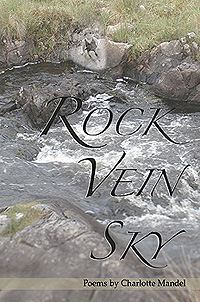Issue 2 - Winter 2010 Reviews Anxious Music Blood Dazzler Cities of Flesh and the Dead Crazy Love Cures and Poisons Dark Card and Mom's Canoe Fire Pond How to Live on Bread and Music Mister Skylight Paternity Perpetual Care Pictures in the Firestorm Rhapsody of the Naked Immigrants Rock Vein Sky Six Lips Slaves to Do These Things Slide Shows The Air around the Butterfly The Guilt Gene the nested object Interviews
 |
Charlotte Mandel’s seventh collection of poetry, Rock Vein Sky, opens with “Sun Rises in Riverside Park,” a spare, meditative poem that seems to answer Charles Olson’s call for a poetry that consists of "one perception immediately and directly (leading) to a further perception.” Beginning in medias res, this opening poem establishes the poet’s fidelity to transitive, liminal states and experiences:
Through expert compression of images, Mandel offers the reader a dynamic snapshot of a world in which object, thought, and action blur, overlap, and are transformed by one another. “Sun Rises in Riverside Park” isn’t just, as Frost said, a “a momentary stay against confusion.” It is a brilliant transcript of a chaotic world caught in constant motion, in which “there is never the same arc of contact.” Mandel’s short, muscular lines contend with the discovery of a unique perspective that is capable of registering “miniscule changes” and “ringing the hours of earth’s silent/drifting net…” In “Flying with Infants,” the third poem in the book, Mandel’s objectivist sensibility tackles the theme of parenthood within the chaotic, contained space of an airplane cabin. The speaker’s observations of a couple flying with their two children are the impetus for meditation:
The speaker’s capacity for wonder emerges here with musicality and imaginative playfulness. Observing the children, she is transformed to a visceral, pre-symbolic state:
Then, just as quickly as she enters this otherworldly realm, the speaker is cast back into the present by the sound of the children’s parents calling their names. Mandel’s capacity to be transformed by the vicissitudes of experience is on full display throughout Rock Vein Sky, as is her extraordinary capacity to identify with the world around her. There are no definitive distances between opposing states, but rather pathways of sound and syntax that connect even the starkest of oppositions (youth/age; innocence/experience; mind/body; life/death).
These sonnets maintain a playfully urgent tone, even as they register the frailty of human life:
Positing death as “God’s will,” or the “director’s rule,” Mandel offers a decisively contemporary take on mortality. Appearing midway through the collection, the final sonnet of “Afterimage” emerges as an ars poetica of sorts: “Stars come to earth with light no longer real./I’ll slant true lines—let morning darkness choose.” One cannot help but hear echoes of Dickinson’s famous axiom here. Like Dickinson, Mandel is interested in exploring and disrupting the borders between subject and object. While Rock Vein Sky relies more heavily upon images to express meaning than Dickinson’s verse, Mandel’s admirable compression of thought, experience, and observation is reminiscent of Dickinson. The third and fourth sections of Rock Vein Sky also seem to harness some of Dickinson’s characteristic linguistic play, which emerges in various moments of interruption, repetition, surprising alliteration, and odd internal rhymes. In “Still Life,” an accomplished meditation on a lengthy marriage, Mandel’s attention to the visual composition of a scene engenders careful critique:
Perhaps the strongest poem in the collection, “Still Life” ruptures and combines the clichéd languages of art and intimacy. In the final stanzas of the poem (above), the speaker uses fractured syntax to express her layers of self-awareness. Through dashes and radical enjambments, the speaker juxtaposes the opinions and perceptions of others with the comfort and knowledge engendered by domestic life. In “Still Life” marriage becomes an enduring “life line” that tethers the speaker to herself and the world. In its careful, complex intelligence, Rock Vein Sky steers clear of “maud-lin sentiment,” even when it addresses the most charged of subjects, such as marriage, motherhood, and grief. Attending to the experiential, the symbolic, and the critical modes of experience, Mandel offers the reader a provocative portrait of the moments that comprise a life. Reviewed by Kara Candito. |
